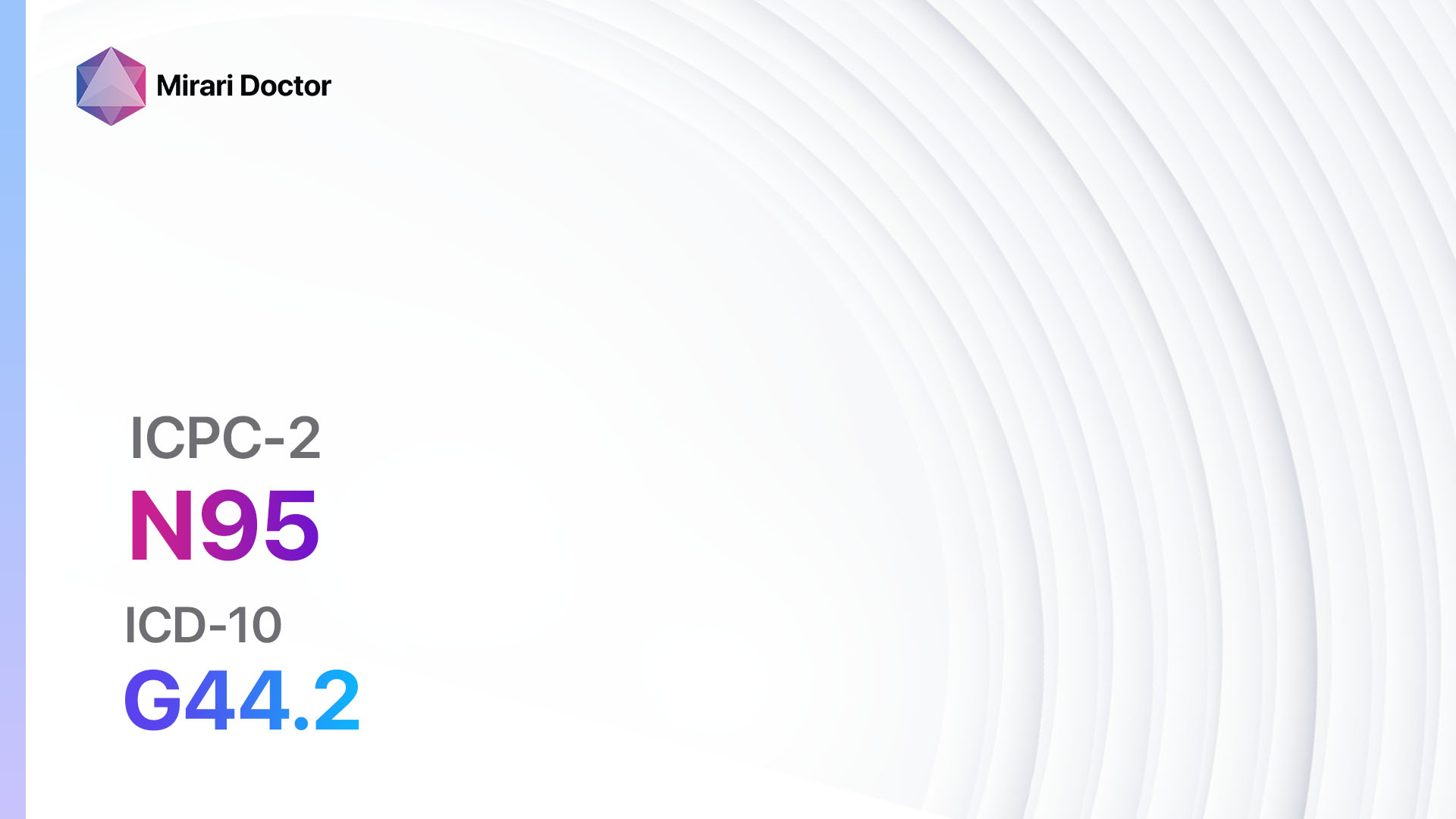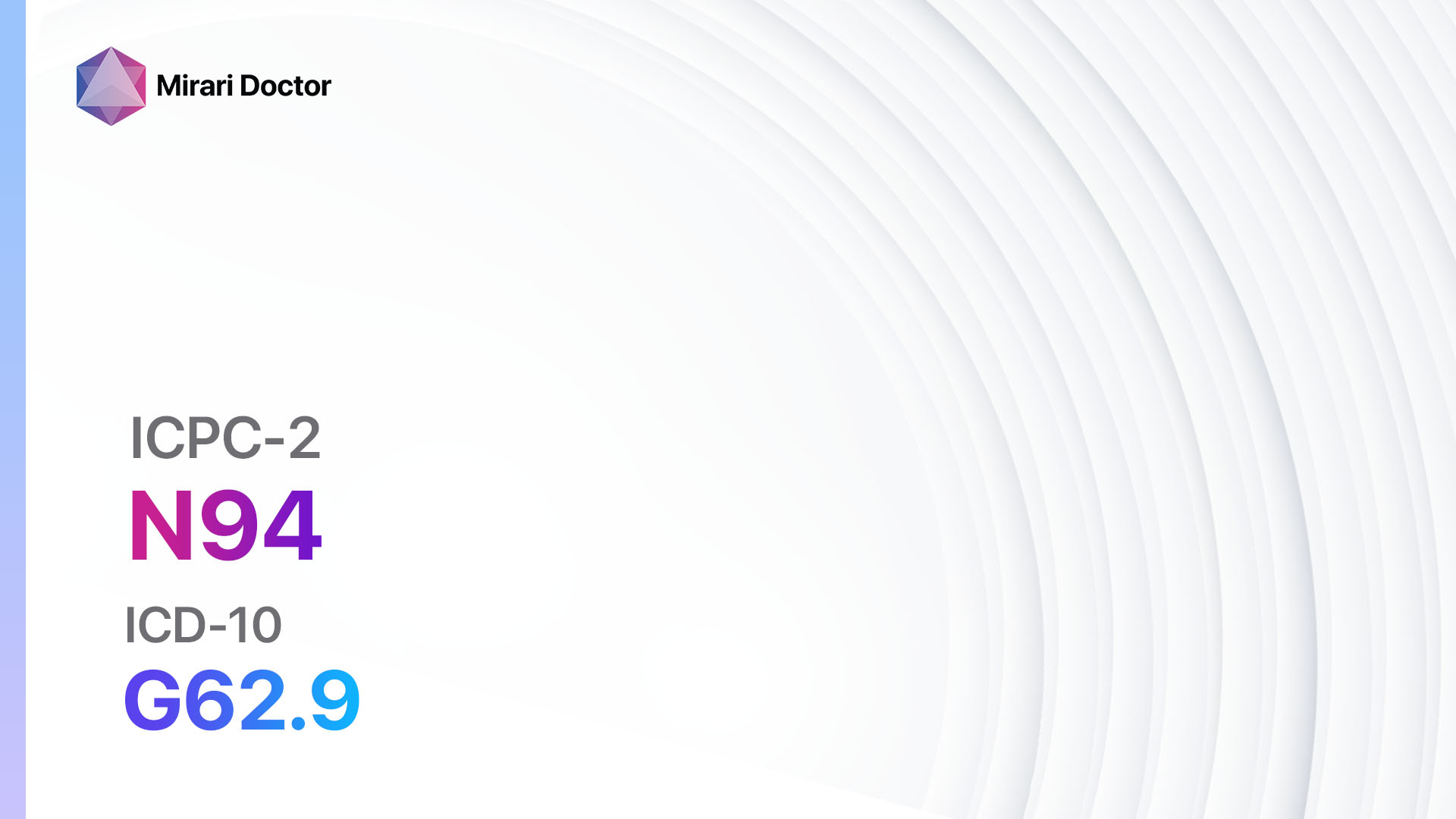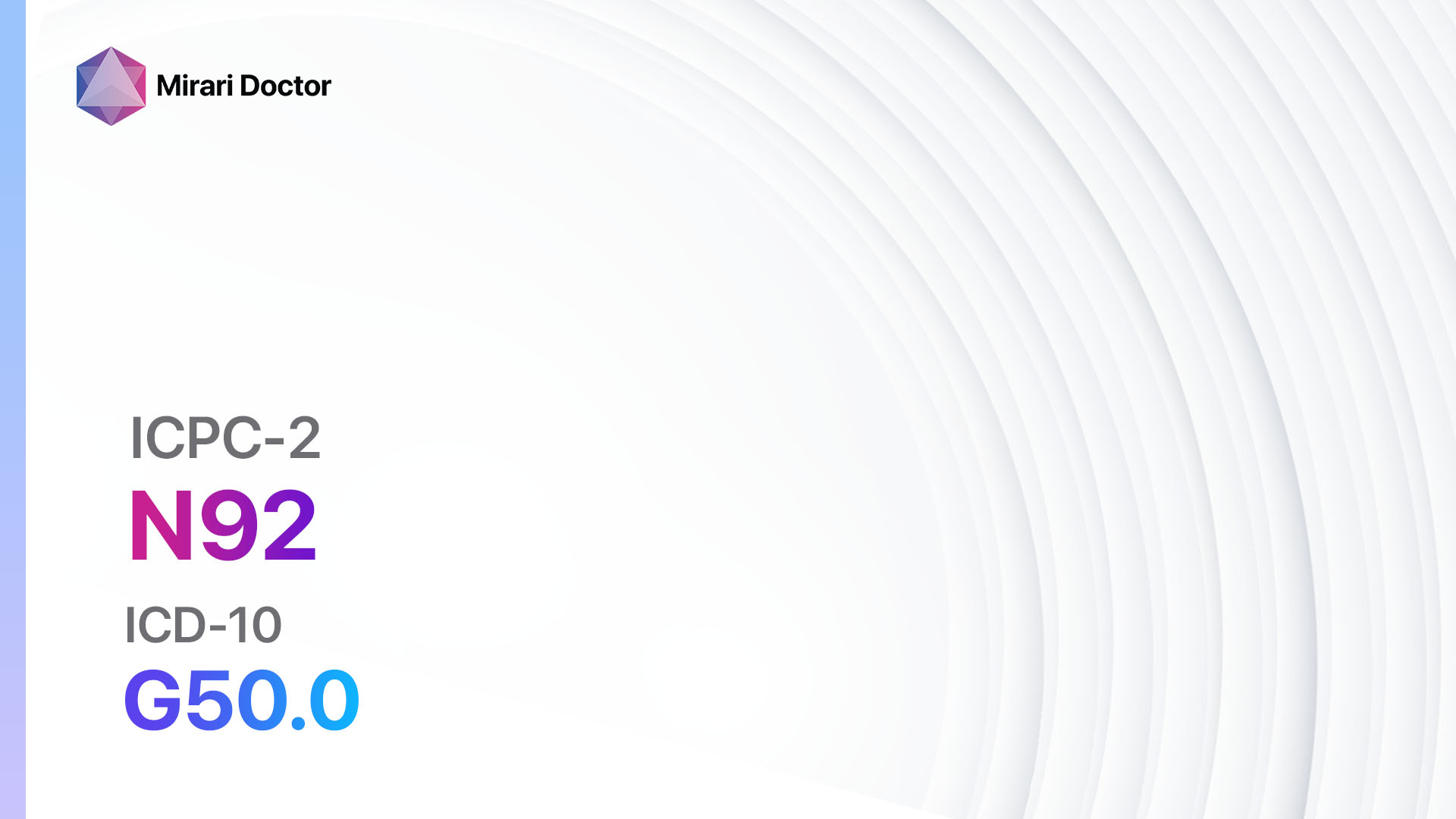
Introduction
Multiple sclerosis (MS) is a chronic autoimmune disease that affects the central nervous system. It is characterized by the destruction of the protective covering of nerve fibers, called myelin, leading to communication problems between the brain and the rest of the body[1]. MS can cause a wide range of symptoms and can vary greatly in severity and progression from person to person. The aim of this guide is to provide an overview of the symptoms, causes, diagnostic steps, possible interventions, and lifestyle interventions for multiple sclerosis.
Codes
Symptoms
- Fatigue: A common symptom of MS, characterized by a persistent feeling of tiredness and lack of energy[2].
- Numbness or tingling: Many people with MS experience numbness or tingling in their limbs, face, or other parts of the body[3].
- Muscle weakness: MS can cause muscle weakness or difficulty with coordination and balance[4].
- Problems with coordination and balance: MS can affect the ability to walk or maintain balance[4].
- Problems with vision: MS can cause blurred or double vision, loss of vision, or pain with eye movement[5].
- Problems with speech and swallowing: MS can affect the muscles used for speech and swallowing, leading to difficulties in these areas[6].
- Cognitive changes: MS can cause problems with memory, attention, and problem-solving[7].
- Emotional changes: MS can lead to mood swings, depression, or or anxiety[8].
- Pain: Some people with MS experience pain, such as muscle or joint pain[9].
- Sexual dysfunction: MS can affect sexual function in both men and women[10].
Causes
The exact cause of multiple sclerosis is unknown, but it is believed to involve a combination of genetic and environmental factors. Potential causes of MS include:
- Autoimmune response: MS is thought to be an autoimmune disease, where the immune system mistakenly attacks the myelin in the central nervous system.
- Genetic factors: Certain genes have been associated with an increased risk of developing MS.
- Environmental factors: Exposure to certain viruses, such as the Epstein-Barr virus, and low levels of vitamin D have been linked to an increased risk of MS.
Diagnostic Steps
Medical History
- Gather information about the patient’s symptoms, including the type, duration, and severity.
- Ask about any previous medical conditions or treatments.
- Inquire about any family history of MS or other autoimmune diseases.
- Assess for any risk factors, such as exposure to certain viruses or low levels of vitamin D.
Physical Examination
- Perform a thorough neurological examination to assess for any abnormalities in coordination, reflexes, strength, and sensation.
- Evaluate the patient’s gait and balance.
- Check for any signs of optic neuritis, such as changes in visual acuity or color vision.
- Assess for any signs of cognitive or emotional changes.
Laboratory Tests
- Blood tests: These can help rule out other conditions that may have similar symptoms to MS, such as Lyme disease or vitamin deficiencies.
- Lumbar puncture (spinal tap): This procedure involves collecting a sample of cerebrospinal fluid to look for abnormalities, such as the presence of certain proteins or immune cells that may indicate MS.
- Evoked potentials: These tests measure the electrical activity in the brain in response to specific stimuli, such as visual or auditory stimuli. Abnormal responses may suggest damage to the nerves.
Diagnostic Imaging
- Magnetic resonance imaging (MRI): This imaging technique can help visualize the brain and spinal cord and detect areas of inflammation or damage to the myelin.
- Computerized tomography (CT) scan: This may be used to rule out other conditions or to assess for any complications of MS, such as brain atrophy or hydrocephalus.
Other Tests
- Visual field testing: This test assesses the peripheral vision and can help detect any visual abnormalities.
- Neurological examination by a specialist: A neurologist may perform a more detailed examination to assess for any specific signs or symptoms of MS.
Follow-up and Patient Education
- Provide the patient with a clear explanation of the diagnosis and prognosis of MS.
- Discuss treatment options and potential interventions.
- Educate the patient about the importance of regular follow-up appointments and monitoring of symptoms.
- Provide resources and support for managing the physical and emotional challenges of living with MS.
Possible Interventions
Traditional Interventions
Medications:
Top 5 drugs for Multiple sclerosis:
- Interferon beta-1a (e.g., Avonex, Rebif):
- Cost: $5,000-$7,000 per month.
- Contraindications: Hypersensitivity to interferon beta-1a or human albumin.
- Side effects: Flu-like symptoms, injection site reactions, liver problems.
- Severe side effects: Depression, suicidal thoughts, severe allergic reactions.
- Drug interactions: None reported.
- Warning: Regular monitoring of liver function and blood counts required.
- Fingolimod (Gilenya):
- Cost: $6,000-$7,000 per month.
- Contraindications: Recent heart attack, certain heart rhythm disorders, severe untreated sleep apnea.
- Side effects: Headache, diarrhea, liver problems.
- Severe side effects: Slow heart rate, increased risk of infections, macular edema.
- Drug interactions: Other medications that affect heart rhythm.
- Warning: Monitoring of heart rate and blood pressure required before and during treatment.
- Dimethyl fumarate (Tecfidera):
- Cost: $7,000-$8,000 per month.
- Contraindications: Hypersensitivity to dimethyl fumarate or any component of the formulation.
- Side effects: Flushing, stomach problems, liver problems.
- Severe side effects: Progressive multifocal leukoencephalopathy (rare), allergic reactions.
- Drug interactions: None reported.
- Warning: Monitoring of liver function required.
- Natalizumab (Tysabri):
- Cost: $6,000-$7,000 per month.
- Contraindications: Progressive multifocal leukoencephalopathy, hypersensitivity to natalizumab.
- Side effects: Headache, fatigue, allergic reactions.
- Severe side effects: Progressive multifocal leukoencephalopathy, liver damage.
- Drug interactions: None reported.
- Warning: Increased risk of infections, regular monitoring required.
- Ocrelizumab (Ocrevus):
- Cost: $6,000-$7,000 per month.
- Contraindications: Hypersensitivity to ocrelizumab or any component of the formulation.
- Side effects: Infusion reactions, upper respiratory tract infections, skin infections.
- Severe side effects: Progressive multifocal leukoencephalopathy, increased risk of malignancies.
- Drug interactions: None reported.
- Warning: Increased risk of infections, regular monitoring required.
Alternative Drugs:
- Glatiramer acetate (Copaxone): Cost: $5,000-$6,000 per month.
- Teriflunomide (Aubagio): Cost: $4,000-$5,000 per month.
- Alemtuzumab (Lemtrada): Cost: $7,000-$8,000 per month.
- Mitoxantrone (Novantrone): Cost: $2,000-$3,000 per month.
- Cladribine (Mavenclad): Cost: $6,000-$7,000 per month.
Surgical Procedures:
- There are no surgical procedures specifically for the treatment of multiple sclerosis. However, in some cases, surgical interventions may be performed to manage complications or symptoms associated with the disease, such as bladder dysfunction or spasticity.
Alternative Interventions
- Acupuncture: May help alleviate symptoms such as pain and fatigue. Cost: $60-$120 per session.
- Yoga and meditation: Can help reduce stress and improve overall well-being. Cost: Varies depending on the location and instructor.
- Massage therapy: May help relieve muscle tension and improve circulation. Cost: $60-$120 per session.
- Dietary supplements: Some supplements, such as omega-3 fatty acids and vitamin D, may have potential benefits for managing symptoms of MS. Cost: Varies depending on the specific supplement.
- Physical therapy: Can help improve strength, balance, and mobility. Cost: $60-$120 per session.
Lifestyle Interventions
- Regular exercise: Engaging in regular physical activity can help improve strength, balance, and overall well-being. Cost: Varies depending on the type of exercise and location.
- Healthy diet: A balanced diet rich in fruits, vegetables, whole grains, and lean proteins can support overall health and well-being. Cost: Varies depending on food choices and dietary preferences.
- Stress management: Finding effective stress management techniques, such as practicing mindfulness or engaging in relaxation exercises, can help reduce the impact of stress on MS symptoms. Cost: Varies depending on the chosen techniques.
- Adequate sleep: Getting enough restful sleep is important for managing MS symptoms. Cost: Varies depending on sleep aids or treatments for sleep disorders, if necessary.
- Smoking cessation: Quitting smoking can improve overall health and reduce the risk of complications associated with MS. Cost: Varies depending on the chosen smoking cessation method.
It is important to note that the cost ranges provided are approximate and may vary depending on the location and availability of the interventions. It is recommended to consult with healthcare professionals for specific cost information and personalized treatment plans.
Mirari Cold Plasma Alternative Intervention
Understanding Mirari Cold Plasma
- Safe and Non-Invasive Treatment: Mirari Cold Plasma is a safe and non-invasive treatment option for various skin conditions. It does not require incisions, minimizing the risk of scarring, bleeding, or tissue damage.
- Efficient Extraction of Foreign Bodies: Mirari Cold Plasma facilitates the removal of foreign bodies from the skin by degrading and dissociating organic matter, allowing easier access and extraction.
- Pain Reduction and Comfort: Mirari Cold Plasma has a local analgesic effect, providing pain relief during the treatment, making it more comfortable for the patient.
- Reduced Risk of Infection: Mirari Cold Plasma has antimicrobial properties, effectively killing bacteria and reducing the risk of infection.
- Accelerated Healing and Minimal Scarring: Mirari Cold Plasma stimulates wound healing and tissue regeneration, reducing healing time and minimizing the formation of scars.
Mirari Cold Plasma Prescription
Video instructions for using Mirari Cold Plasma Device – N86 Multiple sclerosis (ICD-10:G35)
| Mild | Moderate | Severe |
| Mode setting: 2 (Wound Healing) Location: 0 (Localized) Morning: 15 minutes, Evening: 15 minutes |
Mode setting: 2 (Wound Healing) Location: 0 (Localized) Morning: 30 minutes, Lunch: 30 minutes, Evening: 30 minutes |
Mode setting: 2 (Wound Healing) Location: 0 (Localized) Morning: 30 minutes, Lunch: 30 minutes, Evening: 30 minutes |
| Mode setting: 7 (Immunotherapy) Location: 1 (Sacrum) Morning: 15 minutes, Evening: 15 minutes |
Mode setting: 7 (Immunotherapy) Location: 1 (Sacrum) Morning: 30 minutes, Lunch: 30 minutes, Evening: 30 minutes |
Mode setting: 7 (Immunotherapy) Location: 1 (Sacrum) Morning: 30 minutes, Lunch: 30 minutes, Evening: 30 minutes |
| Mode setting: 7 (Immunotherapy) Location: 1 (Sacrum) Morning: 15 minutes, Evening: 15 minutes |
Mode setting: 7 (Immunotherapy) Location: 1 (Sacrum) Morning: 30 minutes, Lunch: 30 minutes, Evening: 30 minutes |
Mode setting: 7 (Immunotherapy) Location: 1 (Sacrum) Morning: 30 minutes, Lunch: 30 minutes, Evening: 30 minutes |
| Total Morning: 45 minutes approx. $7.50 USD, Evening: 45 minutes approx. $7.50 USD |
Total Morning: 90 minutes approx. $15 USD, Lunch: 90 minutes approx. $15 USD, Evening: 90 minutes approx. $15 USD |
Total Morning: 90 minutes approx. $15 USD, Lunch: 90 minutes approx. $15 USD, Evening: 90 minutes approx. $15 USD |
| Usual treatment for 7-60 days approx. $105 USD – $900 USD | Usual treatment for 6-8 weeks approx. $1,890 USD – $2,520 USD |
Usual treatment for 3-6 months approx. $4,050 USD – $8,100 USD
|
 |
|
Use the Mirari Cold Plasma device to treat Multiple sclerosis effectively.
WARNING: MIRARI COLD PLASMA IS DESIGNED FOR THE HUMAN BODY WITHOUT ANY ARTIFICIAL OR THIRD PARTY PRODUCTS. USE OF OTHER PRODUCTS IN COMBINATION WITH MIRARI COLD PLASMA MAY CAUSE UNPREDICTABLE EFFECTS, HARM OR INJURY. PLEASE CONSULT A MEDICAL PROFESSIONAL BEFORE COMBINING ANY OTHER PRODUCTS WITH USE OF MIRARI.
Step 1: Cleanse the Skin
- Start by cleaning the affected area of the skin with a gentle cleanser or mild soap and water. Gently pat the area dry with a clean towel.
Step 2: Prepare the Mirari Cold Plasma device
- Ensure that the Mirari Cold Plasma device is fully charged or has fresh batteries as per the manufacturer’s instructions. Make sure the device is clean and in good working condition.
- Switch on the Mirari device using the power button or by following the specific instructions provided with the device.
- Some Mirari devices may have adjustable settings for intensity or treatment duration. Follow the manufacturer’s instructions to select the appropriate settings based on your needs and the recommended guidelines.
Step 3: Apply the Device
- Place the Mirari device in direct contact with the affected area of the skin. Gently glide or hold the device over the skin surface, ensuring even coverage of the area experiencing.
- Slowly move the Mirari device in a circular motion or follow a specific pattern as indicated in the user manual. This helps ensure thorough treatment coverage.
Step 4: Monitor and Assess:
- Keep track of your progress and evaluate the effectiveness of the Mirari device in managing your Multiple sclerosis. If you have any concerns or notice any adverse reactions, consult with your health care professional.
Note
This guide is for informational purposes only and should not replace the advice of a medical professional. Always consult with your healthcare provider or a qualified medical professional for personal advice, diagnosis, or treatment. Do not solely rely on the information presented here for decisions about your health. Use of this information is at your own risk. The authors of this guide, nor any associated entities or platforms, are not responsible for any potential adverse effects or outcomes based on the content.
Mirari Cold Plasma System Disclaimer
- Purpose: The Mirari Cold Plasma System is a Class 2 medical device designed for use by trained healthcare professionals. It is registered for use in Thailand and Vietnam. It is not intended for use outside of these locations.
- Informational Use: The content and information provided with the device are for educational and informational purposes only. They are not a substitute for professional medical advice or care.
- Variable Outcomes: While the device is approved for specific uses, individual outcomes can differ. We do not assert or guarantee specific medical outcomes.
- Consultation: Prior to utilizing the device or making decisions based on its content, it is essential to consult with a Certified Mirari Tele-Therapist and your medical healthcare provider regarding specific protocols.
- Liability: By using this device, users are acknowledging and accepting all potential risks. Neither the manufacturer nor the distributor will be held accountable for any adverse reactions, injuries, or damages stemming from its use.
- Geographical Availability: This device has received approval for designated purposes by the Thai and Vietnam FDA. As of now, outside of Thailand and Vietnam, the Mirari Cold Plasma System is not available for purchase or use.
References
- Compston A, Coles A. Multiple sclerosis. Lancet. 2008;372(9648):1502-1517.
- Krupp LB, Alvarez LA, LaRocca NG, Scheinberg LC. Fatigue in multiple sclerosis. Arch Neurol. 1988;45(4):435-437.
- Rae-Grant AD, Eckert NJ, Bartz S, Reed JF. Sensory symptoms of multiple sclerosis: a hidden reservoir of morbidity. Mult Scler. 1999;5(3):179-183.
- Feys P, Lamers I, Francis G, et al. The Nine-Hole Peg Test as a manual dexterity performance measure for multiple sclerosis. Mult Scler. 2017;23(5):711-720.
- Balcer LJ, Miller DH, Reingold SC, Cohen JA. Vision and vision-related outcome measures in multiple sclerosis. Brain. 2015;138(Pt 1):11-27.
- Hartelius L, Runmarker B, Andersen O. Prevalence and characteristics of dysarthria in a multiple-sclerosis incidence cohort: relation to neurological data. Folia Phoniatr Logop. 2000;52(4):160-177.
- Chiaravalloti ND, DeLuca J. Cognitive impairment in multiple sclerosis. Lancet Neurol. 2008;7(12):1139-1151.
- Feinstein A. Multiple sclerosis and depression. Mult Scler. 2011;17(11):1276-1281.
- O’Connor AB, Schwid SR, Herrmann DN, Markman JD, Dworkin RH. Pain associated with multiple sclerosis: systematic review and proposed classification. Pain. 2008;137(1):96-111.
- Foley FW, Zemon V, Campagnolo D, et al. The Multiple Sclerosis Intimacy and Sexuality Questionnaire — re-validation and development of a 15-item version with a large US sample. Mult Scler. 2013;19(9):1197-1203.
Related articles
Made in USA



























